Thanks to a favourable topography, Venezuela already had some long range WLAN links, like the 70 km long operated by Fundacite Mérida between Pico Espejo and Canagua.
To test the limits of the WiFi technology, it is necessary to find a path with an unobstructed line of sight and a clearance of at least 60% of the first Fresnel zone.
While looking at the terrain in Venezuela, in search of a stretch with high elevation at the ends and low ground in between, I first focused in the Guayana region. Although plenty of high grounds are to be found, in particular the famous "tepuys" (tall mesas with steep walls), there were always obstacles in the middle ground. My attention shifted to the Andes, whose steep slopes (rising abruptly from the plains) proved adequate for the task. For several years, I have been travelling through sparsely populated areas due to my passion for mountain biking. In the back of my head, I kept a record of the suitability of different spots for long distance communications.
Pico del Aguila is an outstanding place for long distance communication. It has an altitude of 4100 m and is about a two hour drive from my home town of Mérida. For the other end, I finally located the town of El Baúl, in Cojedes State.
Using the free software Radio Mobile
(available at www.cplus.org/rmw/english1.html)I found that there was no obstruction of the first Fresnel zone, over a 280 km path between Pico del Aguila and El Baúl.
Once satisfied with the existence of a suitable trajectory, we looked at the equipment needed to achieve the goal. We have been using Orinoco cards for a number of years.
Sporting an output power of 15 dBm and receive threshold of -84 dBm, they are robust and trustworthy. The free space loss at 280 km is 149 dB. So, we would need 30 dBi antennas at both ends and even that would leave very little margin for other losses. On the other hand, the Linksys WRT54G wireless router runs Linux. The Open Source community has written several firmware versions for it that allow for complete customisation of every transmission parameter. In particular, OpenWRT firmware allows for the adjustment of the acknowledgment time of the MAC layer, as well as the output power. Another firmware, DD-WRT, has a GUI interface and a very convenient site survey utility.
Furthermore, the Linksys can be located closer to the antenna than a laptop. So, we decided to go with a pair of these boxes. One was configured as an AP (access point) and the other as a client. The WRT54G can operate at 100 mW output power with good linearity, and can even be pushed up to 200 mW.
But at this value, non linearity is very severe and spurious signals are generated, which should be avoided. Although this is consumer grade equipment and quite inexpensive, after years of using it, we felt confident that it could serve our purpose. Of course, we kept a spare set handy just in case.
By setting the output power to 100 mW (20 dBm), we could obtain a 5dB advantage compared with the Orinoco card. Therefore, we settled for a pair of WRT54Gs.
On January 15, 2006, I went to Pico Águila to check out the site that Radio Mobile had reported as suitable. The azimuth towards El Baúl is 86°, but since the magnetic declination is 8° 16’, our antenna should be pointed to a magnetic bearing of 94°. Unfortunately, when I looked towards 94°, I found the line of sight obstructed by an obstacle that had not been shown by the software, due to the limited resolution of the digital elevation maps that are freely available. I rode my mountain bike for several hours examining the surrounding area looking for a clear path towards the East. Several promising spots were identified, and for each of them I took photos and recorded the coordinates with a GPS for later processing with the Radio Mobile software.
This led me to refine my path selection, resulting in the one depicted in Figure CsLD 1 using Google Earth:
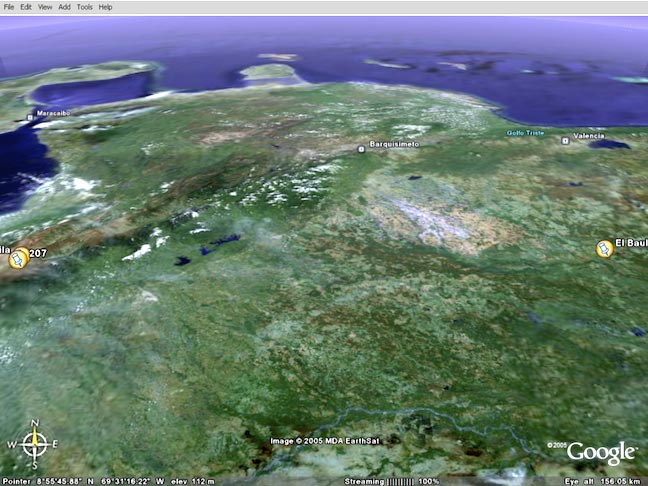 Figure CsLD 1: View of the 280 km link. Maracaibo’s Lake is to the West, and the Peninsula of Paraguaná is to the North.
Figure CsLD 1: View of the 280 km link. Maracaibo’s Lake is to the West, and the Peninsula of Paraguaná is to the North.The radio profile obtained with Radio Mobile is shown in Figure CsLD 2:
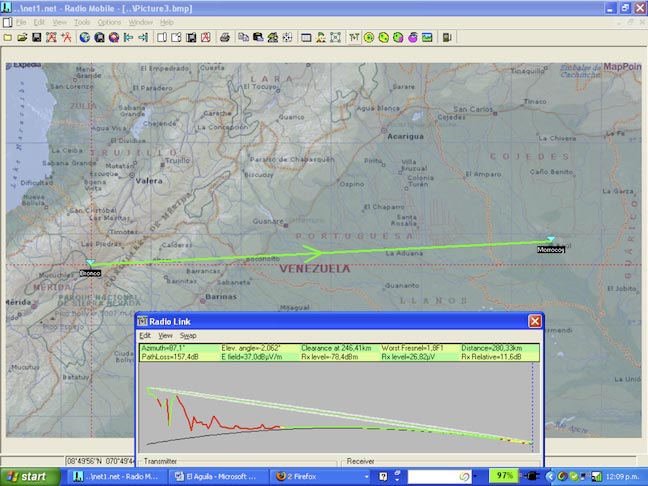 Figure CsLD 2: Map and profile of the proposed path between Pico Aguila, and Morrocoy Hill, near the town of El Baúl.
Figure CsLD 2: Map and profile of the proposed path between Pico Aguila, and Morrocoy Hill, near the town of El Baúl.The details of the wireless link are displayed in Figure CsLD 3:
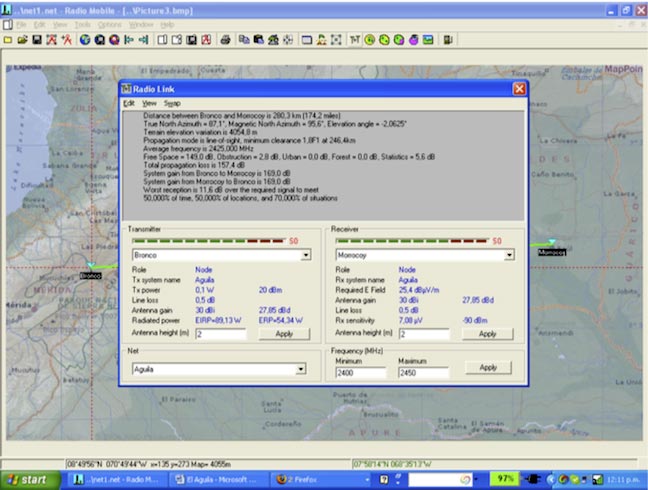 Figure CsLD 3: Propagation details of the 280 km link.
Figure CsLD 3: Propagation details of the 280 km link.In order to achieve a reasonable margin of some 12 dB for the link, we needed antennas with at least 30 dBi gain at each end.
High gain antennas for the 2.4 GHz band were not available in Venezuela.
The import costs are considerable, so we decided instead to recycle parabolic reflectors (formerly used for a satellite service) and replace the feed with one designed for 2.4 GHz. We proved the concept with an 80 cm dish. The gain was way too low, so we tried an offset fed 2.4 m reflector. This offered ample gain, albeit with some difficulties in the aiming of the 3.5° beam. The 22.5° offset meant that the dish appeared to be pointing downwards when it was horizontally aligned.
Several tests were performed using various cantennas and a 12 dBi Yagi as a feed. We pointed the antenna at a base station of the university wireless network that was located 11 km away on a 3500m mountain. The test site sits at 2000m and therefore the elevation angle is 8°. Because of the offset feed, we pointed the dish 14° downward, as can be seen in the following picture:
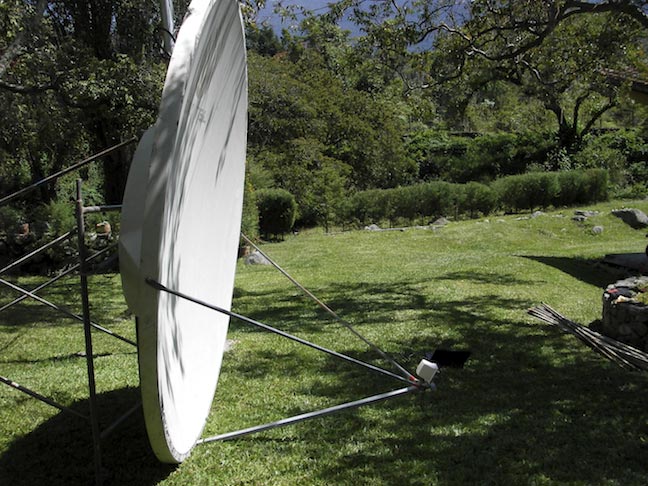 Figure CsLD 4: 2.4 m offset fed reflector with a 12 dBi antenna at its focus, looking 14° down. The actual elevation is 8° up.
Figure CsLD 4: 2.4 m offset fed reflector with a 12 dBi antenna at its focus, looking 14° down. The actual elevation is 8° up.We were able to establish a link with the base station at Aguada, but our efforts to measure the gain of the setup using Netstumbler were not successful. There was too much fluctuation on the received power values of live traffic. For a meaningful measurement of the gain, we needed a signal generator and a spectrum analyser. These instruments were also required for the field trip in order to align the antennas properly. While waiting for the required equipment, we looked for an antenna to be used at the other end, and also a pointing system better suited to the narrow radio beam of a high gain antenna. In February 2006, I travelled to Trieste to participate in the annual wireless training event that I have been attending since 1996. While there, I mentioned the project to my colleague Carlo Fonda, who was immediately thrilled and eager to participate. The collaboration between the Latin American Networking School (EsLaRed) and the Abdus Salam International Centre for Theoretical Physics (ICTP) goes back to 1992, when the first Networking School was held in Mérida with ICTP support. Since then, members of both institutions have collaborated on several activities. Some of these include an annual training school on wireless networking (organized by ICTP) and another on computer networks (organized by EsLaRed) that are hosted in several countries throughout Latin America. Accordingly, it was not difficult to persuade Professor Sandro Radicella, the head of the Aeronomy and Radio Propagation Laboratory at ICTP, to support Carlo Fonda’s trip in early April to Venezuela in order to participate in the experiment. Back at home, I found a 2.75 m parabolic central fed mesh antenna at a neighbours house. Mr. Ismael Santos graciously lent his antenna for the experiment. Figure CsLD 5 shows the disassembly of the mesh reflector.
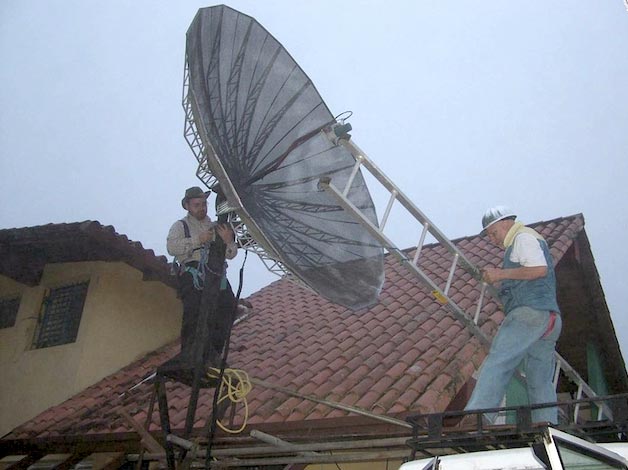 Figure CsLD 5: Carlo and Ermanno disassembling the satellite dish supplied by Mr. Ismael Santos.
Figure CsLD 5: Carlo and Ermanno disassembling the satellite dish supplied by Mr. Ismael Santos.We exchanged the feed for a 2.4 GHz one, and aimed the antenna at a signal generator that was located on top of a ladder some 30 m away. With a spectrum analyser, we measured the maximum of the signal and located the focus. We also pinpointed the boresight for both the central fed and the offset antennas.
This is shown in Figure CsLD 6:
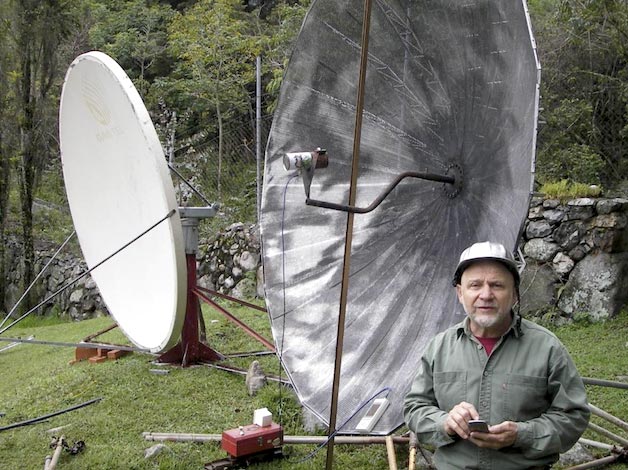 Figure CsLD 6: Finding the focus of the antennas with the 2.4 GHz feed
Figure CsLD 6: Finding the focus of the antennas with the 2.4 GHz feedWe also compared the power of the received signal with the output of a commercial 24 dBi antenna. This showed a difference of 8 dB, which led us to believe that the overall gain of our antenna was about 32 dBi. Of course, there is some uncertainty about this value. We were receiving reflected signals, but the value agreed with the calculation from the antenna dimension.
Once we were satisfied with the proper functioning and aim of both antennas, we decided to do a site survey at the other end of the El Baúl link. Carlo Fonda, Gaya Fior and Ermanno Pietrosemoli reached the site on April 8th. The following day, we found a hill (south of the town) with two telecom towers from two cell phone operators and one belonging to the Major of El Baúl. The hill of Morrocoy is some 75 m above the surrounding area, about 155 m above sea level. It provides an unobstructed view towards El Aguila. There is a dirt road to the top, a must for our purpose, given the weight of the antenna.
On Wednesday April 12th, Javier Triviño and Ermanno Pietrosemoli travelled towards Baúl with the offset antenna loaded on top of a four- wheel drive truck. Early in the morning of April 13th, we installed the antenna and pointed it at a compass bearing of 276°, given that the declination is 8° and therefore the true Azimuth is 268°. At the same time, the other team (composed by Carlo Fonda and Gaya Fior from ICTP, with assistance of Franco Bellarosa, Lourdes Pietrosemoli and José Triviño) rode to the previously surveyed area at Pico del Aguila in a Bronco truck that carried the 2.7 m mesh antenna.
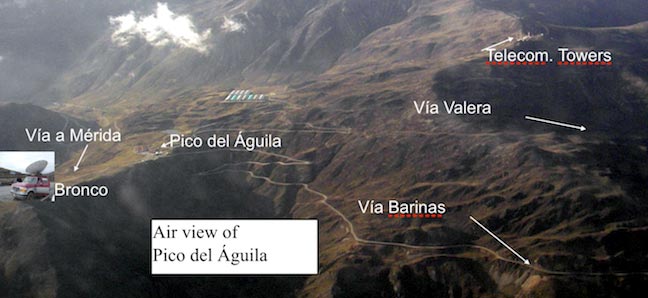 Figure CsLD 7: Pico del Águila and surrounds map with Bronco truck.
Figure CsLD 7: Pico del Águila and surrounds map with Bronco truck.Poor weather is common at altitudes of 4100 m above sea level. The Aguila team was able to install and point the mesh antenna before the fog and sleet began. Figure CsLD 8 shows the antenna and the rope used as an aid in aiming the 3° radio beam.Power for the signal generator was supplied from the truck by means of a 12 V DC to 120 V AC inverter. At 11 A.M in El Baúl, we were able to observe a -82 dBm signal at the agreed upon 2450 MHz frequency using the spectrum analyser. To be sure we had found the proper source, we asked Carlo to switch off the signal. Indeed, the trace on the spectrum analyser showed only noise. This confirmed that we were really seeing the signal that originated some 280 km away. After turning the signal generator on again, we performed a fine tuning in elevation and azimuth at both ends. Once we were satisfied that we had attained the maximum received signal, Carlo removed the signal generator and replaced it with a Linksys WRT54G wireless router configured as an access point. Javier substituted the spectrum analyser on our end for another WRT54G configured as a client.
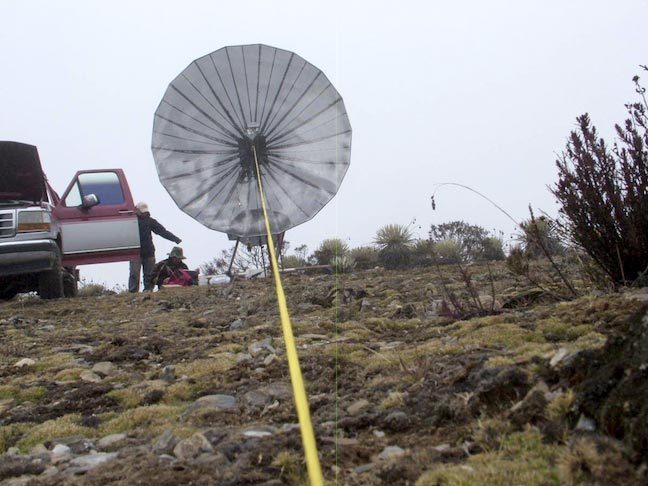 Figure CsLD 8: Aiming the antenna at el Águila.
Figure CsLD 8: Aiming the antenna at el Águila.At once, we started receiving "beacons" but ping packets did not get through. This was expected, since the propagation time of the radio wave over a 300 km link is 1 ms. It takes at least 2 ms for an acknowledgment to reach the transmitter. Fortunately, the OpenWRT firmware allows for adjusting the ACK timing. After Carlo adjusted for the 3 orders of magnitude increase in delay above what the standard WiFi link expects, we began receiving packets with a delay of about 5 ms.
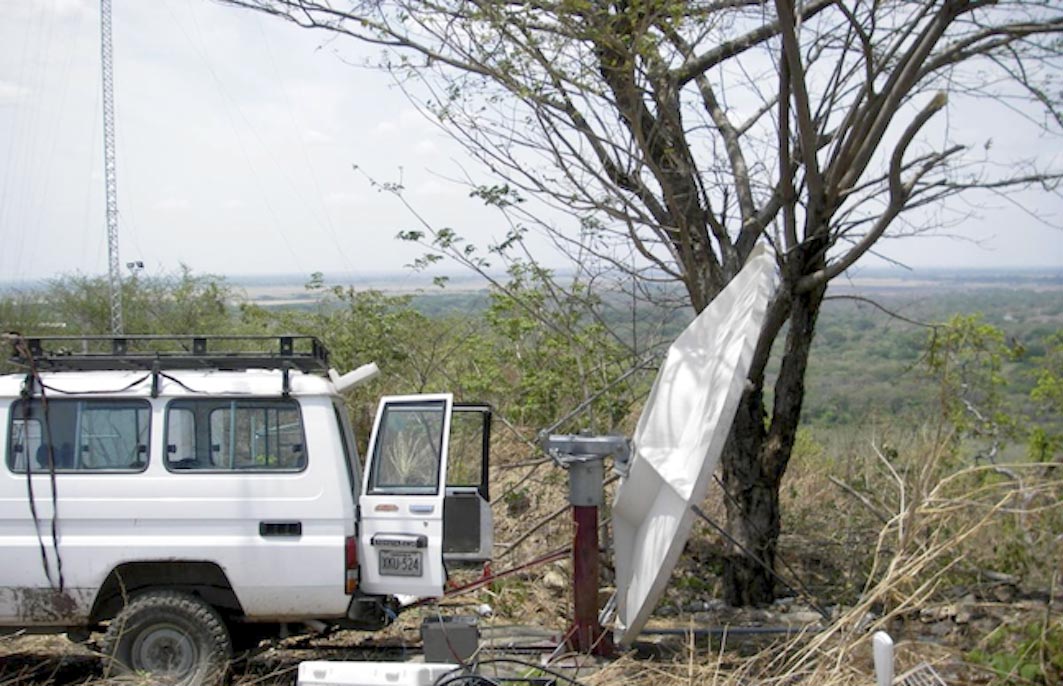 Figure CsLD 9: El Baúl antenna installation. Actual elevation was 1° upward, since the antenna has an offset of 22.5°.
Figure CsLD 9: El Baúl antenna installation. Actual elevation was 1° upward, since the antenna has an offset of 22.5°.We proceeded to transfer several PDF files between Carlo’s and Javier’s laptops. The results are shown in Figure CsLD 10.
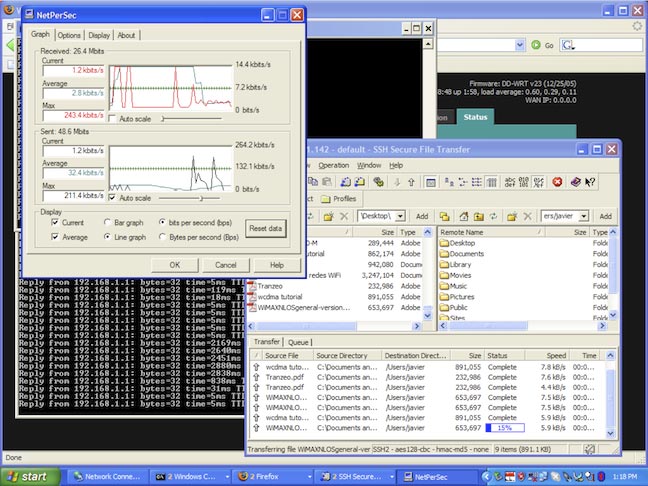 Figure CsLD 10: Screenshot of Javier’s laptop showing details of PDF file transfer from Carlo’s laptop 280 km away, using two WRT54G wireless routers, no amplifiers.
Figure CsLD 10: Screenshot of Javier’s laptop showing details of PDF file transfer from Carlo’s laptop 280 km away, using two WRT54G wireless routers, no amplifiers.Note the ping time of a few milliseconds.
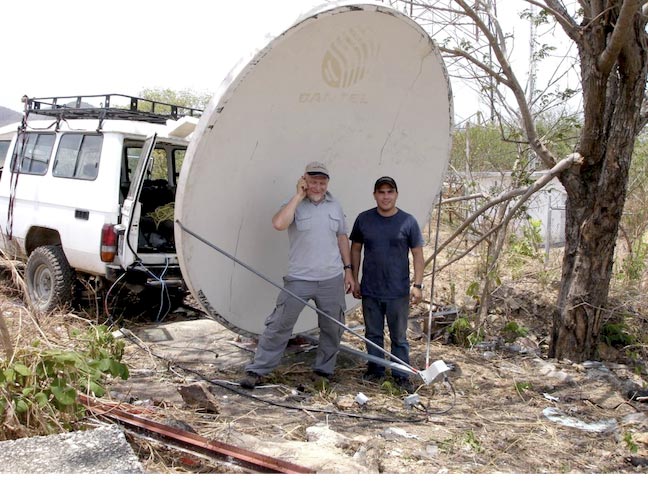 Figure CsLD 11: Javier Triviño (right) and Ermanno Pietrosemoli beaming from the El Baúl antenna.
Figure CsLD 11: Javier Triviño (right) and Ermanno Pietrosemoli beaming from the El Baúl antenna.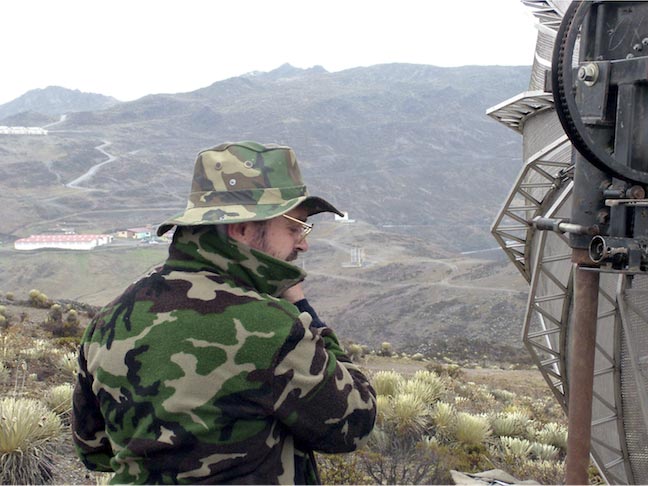 Figure CsLD 12: Carlo Fonda at the Aguila Site
Figure CsLD 12: Carlo Fonda at the Aguila SiteOne year after performing the experiment just described, we found the time and resources to repeat it. We used commercial 30 dBi antennas, and also a couple of wireless routers which had been modified by the TIER group led by Dr. Eric Brewer of Berkeley University. The purpose of the modification of the standard WiFi MAC is to make it suitable for long distance applications by replacing the CSMA Media Access Control with TDMA. The latter is better suited for long distance point-to-point links since it does not require the reception of ACKs. This eliminates the need to wait for the 2 ms round trip propagation time on a 300 km path. On April 28th, 2007, a team formed by Javier Triviño, José Torres and Francisco Torres installed one of the antennas at El Aguila site. The other team, formed by Leonardo González V., Leonardo González G., Alejandro González and Ermanno Pietrosemoli, installed the other antenna at El Baúl. A solid link was quickly established using the Linksys WRT54G routers. This allowed for video transmission at a measured throughput of 65 kbps. With the TDMA routers, the measured throughput was 3 Mbps in each direction. This produced the total of 6 Mbps as predicted by the simulations done at Berkeley.
Thrilled by these results, which pave the way for really inexpensive long distance broadband links, the second team moved to another location previously identified at 382 km from El Aguila, in a place called Platillón. Platillón is 1500 m above sea level and there is an unobstructed first Fresnel zone towards El Aguila (located at 4200 m above sea level). The proposed path is shown in Figure CsLD 13:
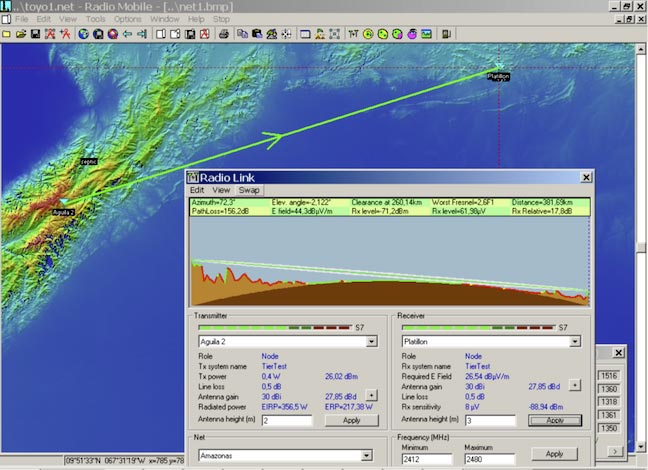 Figure CsLD 13: Map and profile of the 380 km path.
Figure CsLD 13: Map and profile of the 380 km path.Again, the link was quickly established with the Linksys and the TIER supplied routers. The Linksys link showed approximately 1% packet loss, with an average round trip time of 12 ms. The TIER equipment showed no packet loss, with unidirectional propagation times of 1 ms. This allowed for video transmission, but the link was not stable. We noticed considerable signal fluctuations that often interrupted the communication. However, when the received signal was about -78 dBm, the measured throughput was a total of 6 Mbps bidirectional with the TIER routers implementing TDMA.
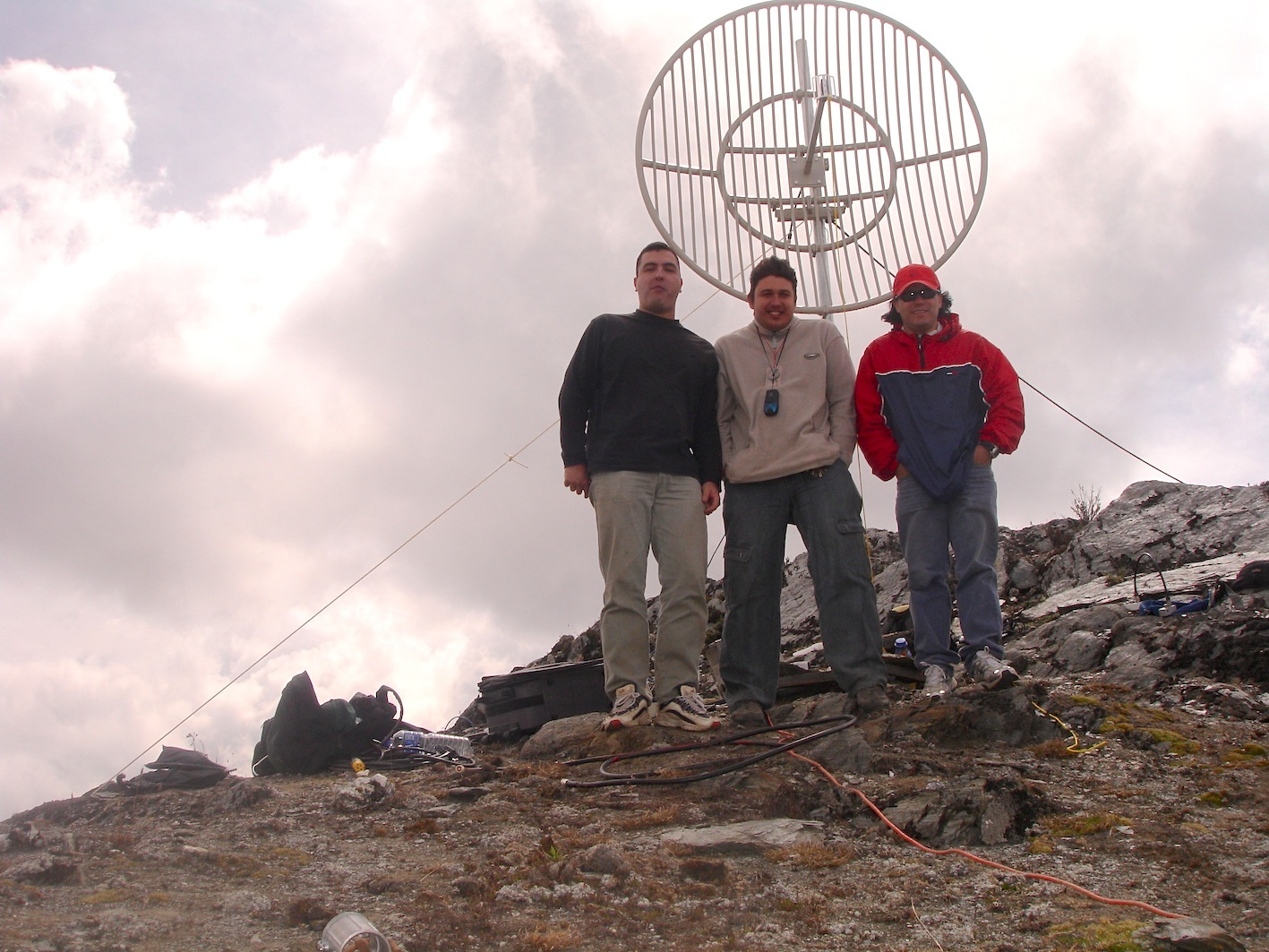 Figure CsLD 14: The team at el Aguila, José Torres (left), Javier Triviño (centre) and Francisco Torres (right).
Figure CsLD 14: The team at el Aguila, José Torres (left), Javier Triviño (centre) and Francisco Torres (right).Although further tests must be conducted to ascertain the limits for stable throughput, we are confident that Wi-Fi has a great potential for long distance broadband communication. It is particularly well suited for rural areas were the spectrum is still not crowded and interference is not a problem, provided there is good radio line of sight.
We wish to express our gratitude to Mr. Ismael Santos for lending the mesh antenna to be installed at El Aguila and to Eng. Andrés Pietrosemoli for supplying the special scaffolding joints used for the installation and transportation of the antennas. We'd also like to thank the Abdus Salam International Centre of Theoretical Physics for supporting Carlo Fonda’s trip from Italy to Venezuela.
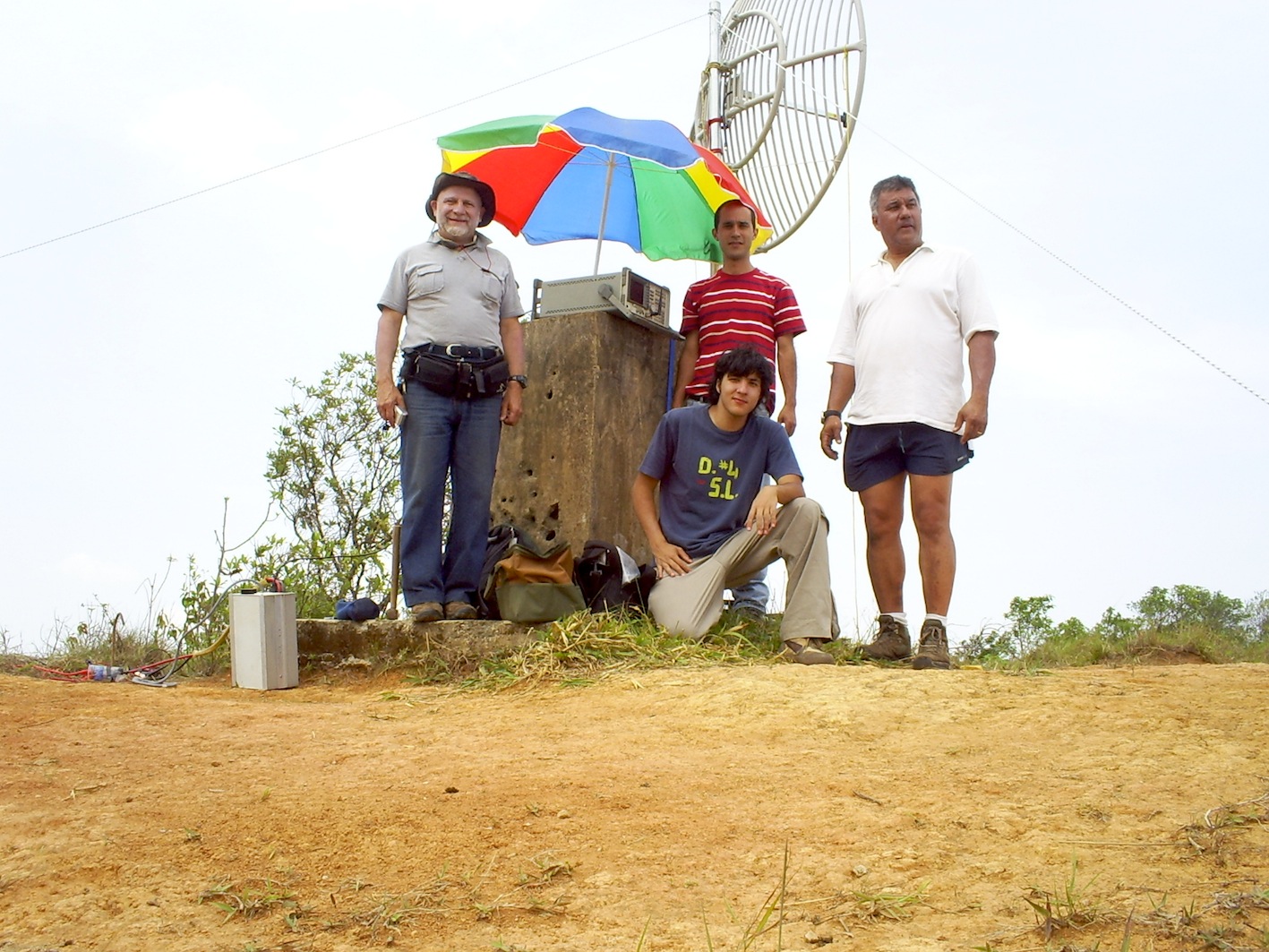 Figure CsLD 15: The team at Platillon. From left to right: Leonardo González V., Leonardo González G., Ermanno Pietrosemoli and Alejandro González.
Figure CsLD 15: The team at Platillon. From left to right: Leonardo González V., Leonardo González G., Ermanno Pietrosemoli and Alejandro González.
OpenWRT Open Source firmware for Linksys - openwrt.org/ www.idrc.ca
Fundacite Mérida - www.fundacite-merida.gob.ve